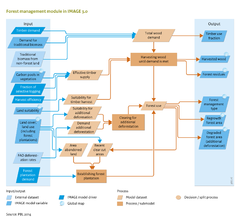Forest management: Difference between revisions
Jump to navigation
Jump to search
No edit summary |
No edit summary |
||
| Line 1: | Line 1: | ||
{{ComponentTemplate2 | {{ComponentTemplate2 | ||
|IMAGEComponent=Scenario drivers; Agricultural systems; Natural vegetation and carbon cycle | |IMAGEComponent=Scenario drivers; Agricultural systems; Natural vegetation and carbon cycle | ||
|KeyReference=Arets et al, 2011 | |KeyReference=Arets et al., 2011; | ||
|InputVar=Timber demand; Demand for traditional biomass; Fraction selective cut;Land cover, land use - grid; | |InputVar=Timber demand; Demand for traditional biomass; Fraction selective cut;Land cover, land use - grid; | ||
Carbon pools in vegetation, soil and timber - grid; Fraction cut down; Forest plantation demand; Suitability rules; Harvesting efficiency; FAO deforestation rates; | Carbon pools in vegetation, soil and timber - grid; Fraction cut down; Forest plantation demand; Suitability rules; Harvesting efficiency; FAO deforestation rates; | ||
|Parameter=Fraction from non-forested land; | |Parameter=Fraction from non-forested land; | ||
|OutputVar=Timber use fraction; Timber harvest fraction - grid; Forest residues; Forest management - grid; Regrowth forest area - grid; Harvested Wood; Degraded forest area; | |OutputVar=Timber use fraction; Timber harvest fraction - grid; Forest residues; Forest management - grid; Regrowth forest area - grid; Harvested Wood; Degraded forest area; | ||
|Description==== Global context === | |Description==== Global context === | ||
Revision as of 14:43, 26 March 2014
Parts of Forest management
| Component is implemented in: |
| Components: |
| Related IMAGE components |
| Projects/Applications |
| Key publications |
| References |
Key policy issues
- How can management influence forest capacity to meet future demand for wood and other ecosystem services?
- What are the implications of forest management for pristine and managed forest areas, and on biomass and carbon stocks and fluxes of relevance for climate policy?
- What are the prospects for more sustainable forest management and the role of production in dedicated forest plantations?
